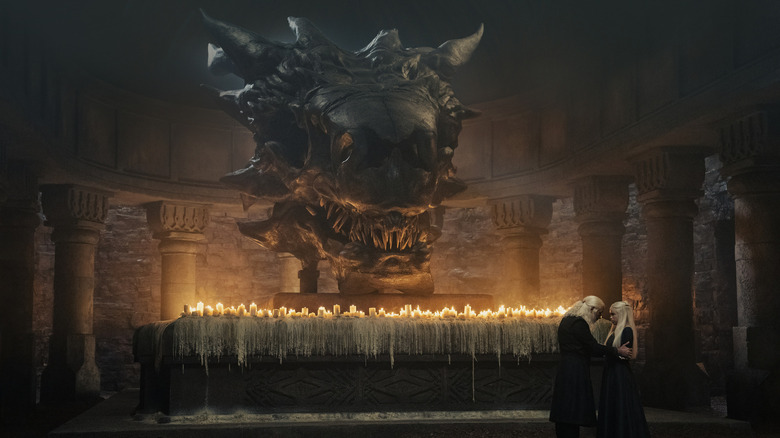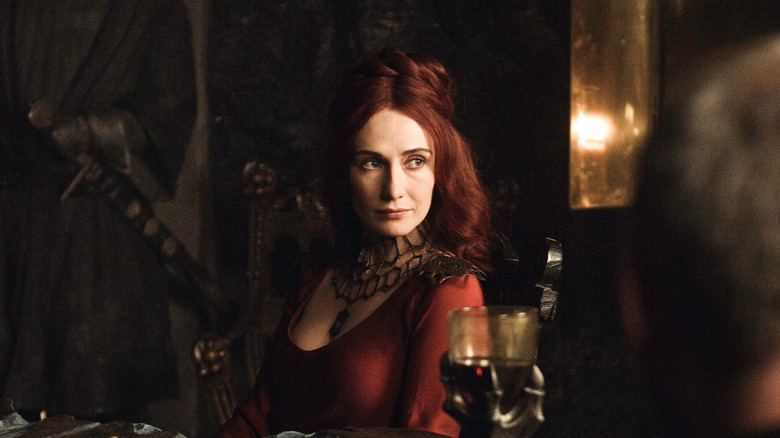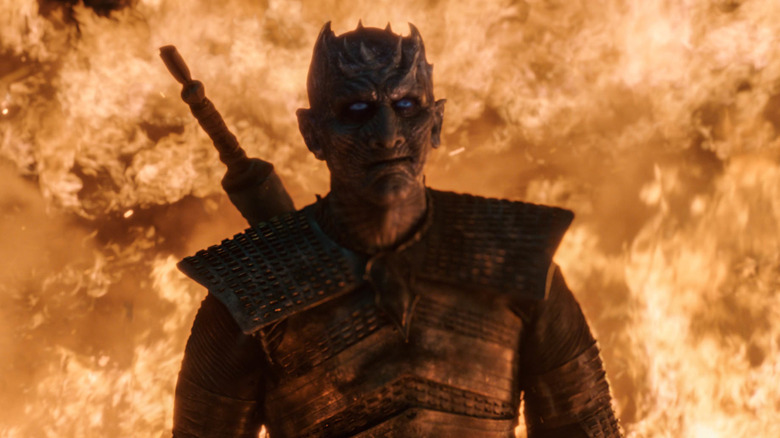House Of The Dragon: What The Song Of Ice And Fire Actually Means
To HBO watchers, “Game of Thrones” is still the dominant blanket title for George R. R. Martin’s expansive fantasy universe. But if you came to the saga of Westeros and Essos from his novels, you’ll know that’s only really the name of the first book in the series. The overarching franchise title is A Song of Ice and Fire, and that name carries much more significance than some casual fans may realize.
In a strictly descriptive sense, the Song of Ice and Fire refers to the two main magical forces in Martin’s world — the evil White Walkers and their army of the undead that dwells in the cold North of Westeros, and the fearsome dragons commanded by the descendants of Old Valyria. These two forces are connected in-universe by a prophecy, interpreted differently by various characters and cultures.
On “House of the Dragon” Season 1, King Viserys I Targaryen (Paddy Considine) reveals to his daughter Rhaenyra (Emma D’Arcy) that Aegon the Conqueror, their ancestor who took over Westeros with dragons, did so in part because he had a vision of the White Walkers attacking. Aegon believed that the Targaryen family must rule a united Westeros in order for the realm to be strong enough to resist this evil. This dream is another connotation for the Song of Ice and Fire, and while it isn’t as explicit in the books, it comes from Martin himself.
In the novels, the Song of Ice and Fire is more vague
George R. R. Martin plays with prophecy constantly in the Game of Thrones books. It’s never said explicitly that Aegon the Conqueror had the vision described on “House of the Dragon,” but there is a scene in the second book, “A Clash of Kings,” that suggests such a prophecy. While wandering through the mystical House of the Undying in Essos, Daenerys Targaryen sees a man bearing the silver hair of her family holding a baby and speaking to a woman who’s supposedly its mother. “He is the prince that was promised,” the man says, “and his is the song of ice and fire.”
Most interpret this scene to be Rhaegar Targaryen, Daenerys’ older brother who was killed by Robert Baratheon, talking to his wife, Elia Martell, about their son Aegon, who’s killed in infancy. Another interpretation is that he could be talking to Lyanna Stark, his supposed secret lover, and that the child is actually Jon Snow, though it would be odd for Rhaegar to name two different sons Aegon. Either way, it’s possible that Rhaegar is referring to the Targaryen prophecy passed down by Aegon the Conqueror. The explicit reference to Aegon’s dream on “House of the Dragon” was suggested by Martin himself.
The “Prince Who Was Promised” reference involves a separate but related prophecy — one that’s much older.
The R’hllor religion and Azor Ahai
In Westeros, the dominant religion centers around a seven-faced god represented by the Seven-Pointed Star. This is why the order’s priests are known as septons (“sept” being the prefix for “seven”). Other faiths, like the Iron Islands’ Drowned God worship and the worship of the Old Gods in the North, also exist. One of the less-explored religions — due to it hailing from Essos — is that of R’hllor, a monotheistic faith that worships R’hllor, the god of fire and light. This religion is primarily represented on “Game of Thrones” by the red priestess Melisandre (Carice van Houten) and the red priest Thoros (Paul Kaye).
The R’hllor religion includes a myth about an ancient hero named Azor Ahai, who wielded a flaming sword and vanquished the forces of R’hllor’s dark opposite, a deity of ice and death, ages ago. The “Prince Who Was Promised” refers to the prophesied reincarnation of Azor Ahai, who will supposedly defend the world against the coming Long Night.
The overlap between the Targaryen prophecy and the ancient myth of Azor Ahai is a constant point of interest in the books, and the blending of legends makes it hard to distinguish which parts of the story come from where. The “Game of Thrones” series, on the other hand, makes the prophecy more active in the final seasons, with Jon Snow and Daenerys Targaryen both held up as potential fulfillers. Unfortunately, the culmination of that storyline on the show is more than a little disappointing.
How Game of Thrones bungled the Song of Ice and Fire
“Game of Thrones” Season 8 is widely hated for a number of reasons, one of which is its bizarre handling of the Song of Ice and Fire prophecy. At the Battle of Winterfell, the Night King and his army of White Walkers and undead abominations face off against the Westeros Avengers for the fate of the world. You’d think that either Jon Snow or Daenerys Targaryen would be the one to save the day, or perhaps some combination of both. But no, it’s Arya Stark (Maisie Williams) who kills the Night King, using the dagger on which Aegon inscribed his dream.
A cool moment for one of the show’s best characters? Absolutely. However, the decision to have Arya kill the Night King has also been a point of bewilderment for many fans. It would seem to suggest that the entire prophecy is meaningless, as Jon and Dany don’t play any real role in the actual victory. If that were the case, though, you’d think there’d be some kind of reflection on the fallibility of prophecy — some commentary to let us know that the showrunners didn’t simply forget a key plotline. Season 8 offers no such reassurance, and in “House of the Dragon,” Aegon’s prophecy is handled with serious gravity, despite longtime “Thrones” viewers knowing it ultimately amounts to a lie.
Perhaps “House of the Dragon” has more in store regarding the Song of Ice and Fire. And, if it doesn’t, we can always hold out hope that one day, Martin might actually finish “The Winds of Winter” and let us see a new version of events.





